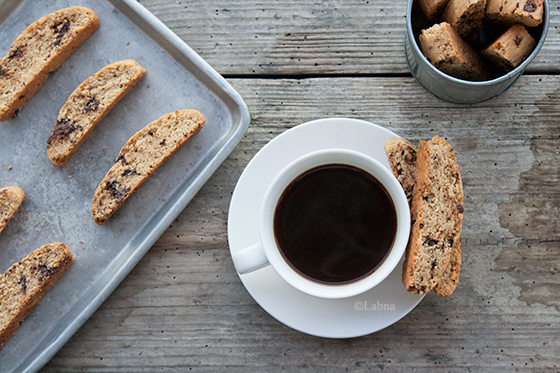Mandelbrodt is an Ashkenazi Jewish dessert and to most people in America is exactly the same as biscotti, the kind of cookies that in Italy would go under the name of cantucci instead: so many names for one single recipe!

Biscotti is the plural form of biscotto. The word originates from the medieval Latin word bis-coctus, meaning “baked twice”; the word biscotti, in fact, defined twice baked goods that were very dry and could be stored for long periods of time, as we know from Pliny the Elder, who boasted that such goods would be edible for centuries. Such non-perishable food was particularly useful during journeys and wars, and twice baked breads were a staple food of the Roman Legions.
The Yiddish word mandelbrodt literally means almond bread; it’s a type of cookie made by forming dough into a loaf, baking it, slicing the loaf into oblong cookies and baking again, just like Italian biscotti (or cantucci, if you prefer).
The crunchy, dry mandelbreads were popular in Eastern Europe among rabbis, merchants and other itinerant Jews as a staple dessert that kept well and could be served on every occasion, including Shabbat, because there’s no milk involved in the recipe.
The precise origin of mandelbrodt is unknown, as is its historic relationship with the famous biscotti from Prato, but all these similarities can’t be fortuitous. With a large Jewish population in Piedmont, Italy may have been the place where Jews first tasted biscotti and later brought them to Europe.
We can say for sure that mandelbrodt cookies date back to the early nineteenth century, while biscotti were first made in the Middle Ages, so biscotti certainly came before mandelbrodt, then probably travelled a lot, like every good recipe does.
Yield 30 cookies
- 2 cups all-purpose flour
- 1 teaspoon baking powder
- 2 large eggs
- ¾ cup sugar
- ½ cup vegetable oil
- 1 tablespoon pure vanilla extract
- 3 ounces semisweet chocolate, coarsely chopped
- 3 ounces almonds, coarsely chopped
Directions
Stir the flour and baking powder together in a medium-size bowl, and set it aside.
Whisk the eggs, sugar, oil, and vanilla in a large bowl. Gradually stir in the flour mixture, followed by the chocolate chips. The dough will be very sticky. Cover the bowl and refrigerate overnight.
Preheat the oven to 350° F and line a baking sheet with parchment paper.
Divide the dough into 2 rectangular logs. Place the logs on the prepared baking sheets and bake them until the tops are firm to the touch, about 25 minutes.
Remove the baking sheets from the oven, but leave the oven on. Let the logs cool for 5 minutes on the baking sheets, then, using a serrated knife, cut each log diagonally into ¾-inch-thick slices.
Place the slices, cut side down, back on the baking sheets, and bake for 7 more minutes.
Turn the oven off and leave the cookies in the oven for at least 1 hour, so they will dry completely.
Because most of the moisture is baked out of them, these cookies have a fairly long shelf life: store them in an airtight container or in a tin box, and they will keep virtually forever.





